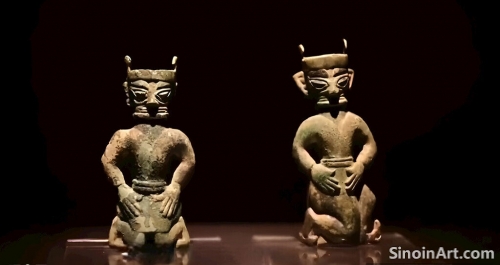Bronze Ware and the Representation of Power in Ancient Chinese Royal Courts
|
Bronze ware played a vital role in representing power and authority in ancient Chinese royal courts, used in ceremonies, displays of wealth, and as tools for maintaining social hierarchies. The careful use and arrangement of bronze artifacts helped to communicate clear messages about power and status. The use of bronze in royal courts helped to solidify both their political and social control.  Bronze vessels, often used in lavish banquets, court ceremonies, and ancestral rites, were key symbols of royal authority, with their size, quality, and decoration reflecting the power and prestige of the ruler and his court. The presence of these finely crafted and deeply symbolic pieces emphasized the wealth and status of the royal class. The integration of these artifacts into court life helped to establish a sense of order and grandeur.  Bronze instruments, such as bells and drums, were used to accompany court performances, further enhancing the opulence and symbolic weight of these events, and emphasizing the power and authority of the ruling class. The use of music and the visual presence of these instruments helped to create a unique and highly structured setting for royal ceremonies and festivals.  The control over bronze resources, and the skills needed to make these pieces, further solidified the power and authority of the ruling class, setting them apart from the rest of society. The management of bronze production helped the rulers to reinforce both their social and political power. The study of bronze ware in the context of royal courts helps to illuminate the complex interplay between material culture, power, and the representation of authority in ancient Chinese civilization. The careful design and management of these objects reveals much about the beliefs and values of the era. |
Tag : bronze royal courts, ancient Chinese power, imperial symbols, court rituals, bronze authority
Related information
- The Use of Bronze in Ancient Chinese Musical Instruments: Stringed Instruments and Percussion
- The Role of Bronze in Ancient Chinese Communication: Inscriptions, Messages, and Records
- The Influence of Tang Dynasty Kaishu Calligraphy on Bronze Inscriptions
- The Influence of Tang Dynasty Culture on the Design and Decoration of Bronze Ware
- Bronze Vessels and Music Performance in Ancient China: A Multi-Sensory Experience
This article explores the diverse use of bronze in ancient Chinese musical instruments, highlighting its role in creating components for stringed instruments, percussive elements, and how it shaped the musical landscape of ancient China beyond bells and chimes.
This article explores the role of bronze in ancient Chinese communication, highlighting how bronze objects were used to record messages, transmit laws, document events, and how they served as a medium for communication and knowledge transmission.
This article explores the influence of Tang Dynasty Kaishu calligraphy on bronze inscriptions, highlighting how its elegant and structured forms impacted the style of carved characters and reflecting the artistic interplay between calligraphy and metalworking.
This article explores the influence of Tang Dynasty culture on bronze ware, highlighting new forms, decorative techniques, and their shift toward more refined and elegant designs that reflect the style of the period, and its focus on elegance and beauty.
This article explores the combination of bronze vessels and music in ancient Chinese ritual performance, highlighting how these combined to create a multi-sensory experience that engaged both visual and auditory senses, and enhanced the power of ritualistic ceremonies.